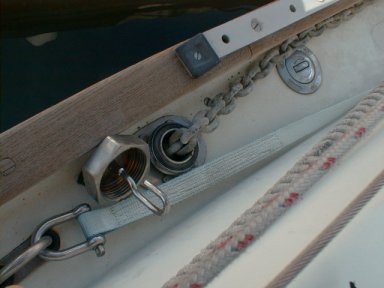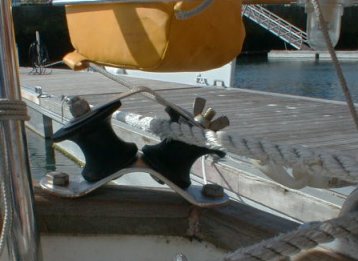

 |
| Our substantial windlass, chain and anchor hold us securely through thick and thin. |
The ground tackle of a long-distance pocket cruiser is a real headache to plan. I collected stories, thoughts and advice for some years before I set up our present arrangement. Rusalka Mist came to me with twice the manufacturer's specified length of chain - 60 m rather than 30 m - and a 25 lb. CQR anchor. This kept us safely anchored on many a Summer cruise and lunch in the bay.
This lot of 5/16 inch chain and the hook was pretty exhausting to pull up and communication with Nicky on the helm was impossible because by half way through the job I was too breathless to shout back to her! The question was always in my mind: Would this do, night after night, in indifferent holding, in far-off anchorages? Having lunch at anchor is one thing but going to bed and sleeping soundly with no-one on watch is quite another. Have a look at page 5 of our West Country under Sail story to see one of our tales. What about shopping trips and sight-seeing ashore? Could we regularly leave the boat anchored in bays, happy that she'll always be there for us to come home to?
I studied various manufacturers' and suppliers' catalogues to see what they recommended in the way of chain and anchor sizes for boats like ours. I found that in different ways they recommend just about everything somewhere or other. It all depends what you want of course, but this did not really help. Some of the most sensible suppliers did things like provide a table of boat sizes, anchor types and anchor weights then say, 'For extended or unattended anchoring choose an anchor two sizes bigger than above'.
 |
| The windlass is very efficient and either of us can easily heave the heavy gear. |
I read up about the theory of it all too. Anchors are considered to drag as soon as the last link of chain before the stock lifts off the mud. The pull on anchor must be at or below the horizontal. Catenary equations exist which allow you to calculate the force necessary to do this under various conditions. In order to prevent it happening you either have to have more chain out, or use a heavier chain. Some yachtsmen, particularly in America, do not use chain apart from the last few meters, preferring rope. Some theorists reckon that it is not the steady pull that drags an anchor but the snatching and jerking. They may argue that the elasticity in nylon anchor cable more than compensates for its lack of weight and catenary effect.
My feeling, and experience, is that it's not the jerking which does it but the slewing around. A yacht at anchor (well this one anyway) does not sit pointing at the hook when the wind begins to get up. She soon gets the wind on one side of the bow and 'sails' off, say to port, with the wind in the starboard bow. She goes away like this until the anchor cable is pulling at quite an angle - nearly 90° - off to starboard from the bow-roller. At this point she will 'tack', get the wind on her port bow and swing off in a big arc the other way. The pull on the anchor therefore comes from everywhere in an arc of up to 180° with the strongest pulls at the two extremes of this range (causing the 'tacks').
 |
| For shorter and coastal journeys the main anchor is kept firmly lashed in the bow-roller. It can be stowed on brackets welded to the pulpit too. |
I have read about this effect as well as experiencing it many times. Other data tables exist which allow you to calculate the wind forces acting on your boat so as to be able to estimate the work your proposed anchor will have to do. Only the wisest of these tell you to calculate the windage not on the bow of your boat, but on its broadside as this is what she will present to the wind at the worst moments of this ranging around. When a boat drags it is just before one of the 'tacks'. The anchor is plucked out before it is able to pull the bow - sideways - through the wind. Dragging boats stay at this sharp angle to the wind and drift backwards almost broadside-on through an anchorage, "...with all the grace of a stampeding randy elephant," I read somewhere.
The last part of the theory involves calculating the amount of cable to lay. What you know is the depth of water. You could calculate something from catenary equations but what you do not know is the force that the boat will exert at some point during the night after the wind has reached its peak. The rule of thumb I use now is twelve times the square-root of the depth. This is safe under most conditions but in a storm, you just put it all out! You do not need a calculator on deck for the square root: root-4 is 2, root-9 is 3, so root-6 is 'two-and-a-half' for our purposes (2.449 in fact). Two-and-a-half twelves are 30, so 30 m of chain normally does for 6 m of water.
 |
| Nicky holds the anchor 'Cock-a-Bill', ready to lower gently by slipping the clutch on that marvellous windlass. |
So, what have we got? I decided to get a 35 lb CQR (I like the hinge in the stock, regarding the ranging or slewing described above) and 60 m of 3/8-inch chain. There is no way I could lift all this by hand so we needed a windlass. I often dreamt of a powered windlass until I read of someone's getting a short-circuit which switched it on with the anchor stowed in the bow roller. It did a lot of mechanical, structural damage apparently, before catching fire, and cooking the batteries. I chose a Simpson Lawrence 'Sea Tiger' 555 manual unit. This has been in continuous production for 30 years or more so must be ok. Their next size down apparently relies on a piece of bicycle chain inside, but not the Sea Tiger - solid castings and machining right through, I'm told. The photos show Nicky raising the anchor in about 7 m of calm water and she only had to stop once to re-arrange her stance. No problem.
I did not want to ditch the existing tackle so I had my local stainless-steel fabricators weld a few things together. First I needed a couple of extra stowage hooks on the pulpit so that the 35 and the 25 lb anchors could be stowed out of the bow roller. Most of the time the 35-lb main anchor lives in the roller. Secondly there was the problem of where to stow the old 5/16-inch chain. There is plenty of room in the cockpit lockers, but we needed a completely sealable hawse fitting in the side-deck.
 |
 |
| O-ring seals and the thread on the outside make our hawse pipes on the side-decks completely waterproof. | The cable (chain one side and mixed chain/nylon anchorplait the other) can be laid out either fore or aft. |
My first thought was a water- or fuel-filler but these are, at best, bronze castings with the thread and seal on the inside of the fixed tube. Rattling 60 m of steel chain in and out through this would soon ruin the thread, so I asked for one to be made with the thread on the outside of the tube. I was lucky, the fabricators had just finished a pipework job at the local brewery and had in stock some food-quality stainless pipe end-fittings with matching nuts and O-rings. These were modified and one fitted on each side-deck. Hooks fitted to the inside of the plates which seal the big nuts serve to hold the last link of our two spare anchor cables. One of these is the old 60-m length of chain and the other is 60 m of 16 mm anchorplait nylon rode spliced to 10 m of 5/16 in chain.
 |
| A pair of stern rollers are useful for stern anchor cables as well as for towing and deploying the storm-drogue. They also come in handy in harbour for sternlines and when using the primary sheet-winches for warping. |
All three cables are marked with 1, 2, 3, 4, 5 and 6 red marks at the 10 m, 20 m, 30 m, 40 m, 50 m and 60-meter points and single yellow marks painted on the 5's, in between. There are also two sets of rollers on the rail at either end of the transom to allow the side-deck rodes to be led over the stern (they can also be led up the side-decks to reach the bow if needed). I have large cleats outside the cockpit coamings which will serve to belay these cables when they are used aft. These aft cables can be used either for bow-in Mediterranean-style mooring or for attachment to the sea-drogue, used in storm-survival tactics. They may also be useful when kedging, or laying out an anchor by dinghy to pull us off, say a mud-bank. The nylon rope warp can be used on the primary jib-sheet winches which are also geared and can give a very good pull.
For good measure I have bought a large fisherman-style hook anchor which is attached to the floor inside one of the cockpit lockers on wooden chocks resined to the inside of the hull. The few bottoms where a CQR is not the best anchor-type (rock and heavy weed) apparently the fisherman saves the day. We shall see.
We have three oversize anchors and three oversize cables. Each of these, including the windlass, is 'suitable', they say, for a 40 or 50-ft boat. Between the lot of them we should be able to sleep soundly anywhere in our 28 feet of floating home. God willing...